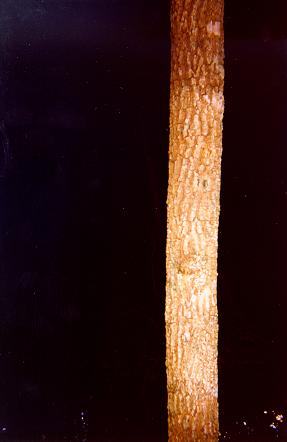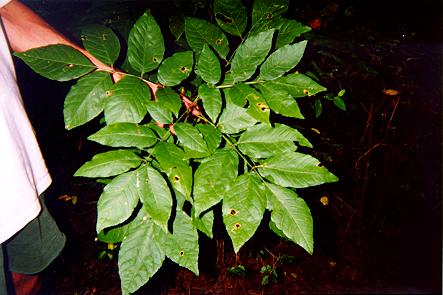

common names:
Identification: Carl Linnaeus (1708-1778), a Swedish botanist and physician, first described F. americana in the book Species Plantarum.Stafleau et al., 1981 Exactly where the specimens were collected and their current location was not found. The White Ash ranges from medium to large in size, often standing over 80 feet in height with a diameter of 2-3 feet.Brown et al., 1990 The leaves are "8-12 inches long; 5-9 (mostly 7) leaflets, ovate to oblong-lanceolate, 3-5 inches long, entire or obscurely toothed, dark-green above and paler and usually glabrous below, petiolules 1/4-1/2 inche long."Preston, R., 1976 The flowers are dioecious and u sually appear before the leaves. C.S Sargent described the flowers in 1965 as "compact ultimately elongated glabrous panicles from buds covered with dark ovate scales rounded at apex and slightly keeled on the back; clayx campanulate, slightly 4-lobed in the staminate flower, and deeply lobed or laciniately cut in the pistillate flower: stamens 2 or occasionally 3, with short stout filaments, and large oblong-ovate apiculate anthers at first nearly black, later becoming reddish purple, ovary contracted i nto a long slender style divided into 2 spreading dark purple stigmatic lobes."Sargent, C.S., 1965 The samara shapedfruit by mid-summer is 1-2 inches long. It persists into winter on the twigs.Preston, R., 1976 The twigs are grayish-green, stout, rounded with narrow and deeply notched leaf scars. There are also numerous bundle scars.Brown et al., 1990 The bark is "gray, th ick, rough, becoming deeply and narrowly fissured with forking, interlacing ridges forming a somewhat diamond-shaped pattern."Brown et al., 1990
 |  |
Geography: The White Ash range extends from Nova Scotia to Maine. Then it goes west to Minnesota and south to Texas and Florida.(Collingwood et al., 1974)
Fraxinus americana | ||
| AREA | STATUS | REFERENCES |
| North America: Continental United States; Canada |
Yes | (Collingwood et al., 1974) |
| Eastern North America: United States east of Mississippi; Ontario and eastern Canada |
Yes | (Collingwood et al., 1974) |
| Southeastern United States: AL AR DE DC FL GA KY MD NC SC TN VA WV |
Yes | (Collingwood et al., 1974) |
| Southern Appalachian
States: AL GA KY MD NC SC TN VA WV |
Yes | (Collingwood et al., 1974) |
| Coastal Plain | rare | Jones et al. 1988 |
| Piedmont | Widespread | (Collingwood et al., 1974) |
| Blue Ridge Mountains | rare | (Collingwood et al., 1974) |
| Great Smoky Mountains National Park | Yes | (Collingwood et al., 1974) |
| Ridge and Valley | Yes | (Collingwood et al., 1974) |
| Cumberland Plateau | Yes | (Collingwood et al., 1974) |
| Central Arch | yes | (Collingwood et al., 1974) |
| Georgia | common | Jones et al. 1988 |
| Clarke County, Georgia | common | Jones et al. 1988 |
| Sams Farm | no | Jenny Janis, Pers. Ob. |
| Old Field | no | Jenny Janis, Pers. Ob. |
| Wetland | no | Jenny Janis, Pers. Ob. |
| Woods | no | Jenny Janis, Pers. Ob. |
| 1-Hectare Plot | no | Jenny Janis, Pers. Ob. |
How to encounter: I did not see any of this species at Sam's farm, but the Green and White Ash are hard to distinguish from each other. I did find it at High Meadows Summer Camp in Roswell Georgia. It grows in the woods near the Hig h Meadows's pool. There are lots of pine surrounding the specimens I photographed. The spring and summer would be the best time to try to find it because it loses its leaves in the fall and winter.
References: